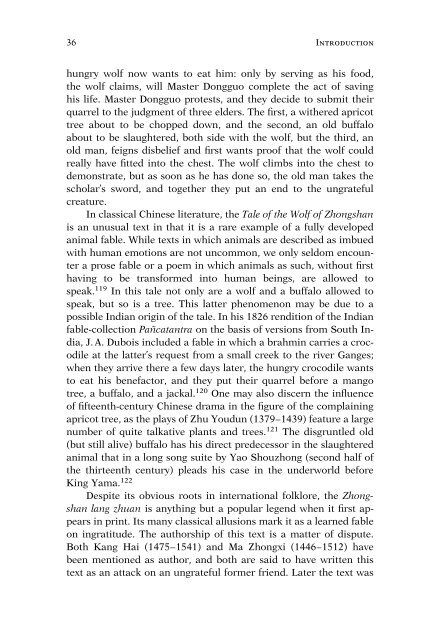Two Precious Scroll Narratives of Guanyin and Her ... - Khamkoo
Two Precious Scroll Narratives of Guanyin and Her ... - Khamkoo
Two Precious Scroll Narratives of Guanyin and Her ... - Khamkoo
Create successful ePaper yourself
Turn your PDF publications into a flip-book with our unique Google optimized e-Paper software.
36 Introduction<br />
hungry wolf now wants to eat him: only by serving as his food,<br />
the wolf claims, will Master Dongguo complete the act <strong>of</strong> saving<br />
his life. Master Dongguo protests, <strong>and</strong> they decide to submit their<br />
quarrel to the judgment <strong>of</strong> three elders. The first, a withered apricot<br />
tree about to be chopped down, <strong>and</strong> the second, an old buffalo<br />
about to be slaughtered, both side with the wolf, but the third, an<br />
old man, feigns disbelief <strong>and</strong> first wants pro<strong>of</strong> that the wolf could<br />
really have fitted into the chest. The wolf climbs into the chest to<br />
demonstrate, but as soon as he has done so, the old man takes the<br />
scholar’s sword, <strong>and</strong> together they put an end to the ungrateful<br />
creature.<br />
In classical Chinese literature, the Tale <strong>of</strong> the Wolf <strong>of</strong> Zhongshan<br />
is an unusual text in that it is a rare example <strong>of</strong> a fully developed<br />
animal fable. While texts in which animals are described as imbued<br />
with human emotions are not uncommon, we only seldom encounter<br />
a prose fable or a poem in which animals as such, without first<br />
having to be transformed into human beings, are allowed to<br />
speak. 119 In this tale not only are a wolf <strong>and</strong> a buffalo allowed to<br />
speak, but so is a tree. This latter phenomenon may be due to a<br />
possible Indian origin <strong>of</strong> the tale. In his 1826 rendition <strong>of</strong> the Indian<br />
fable-collection Pañcatantra on the basis <strong>of</strong> versions from South India,<br />
J. A. Dubois included a fable in which a brahmin carries a crocodile<br />
at the latter’s request from a small creek to the river Ganges;<br />
when they arrive there a few days later, the hungry crocodile wants<br />
to eat his benefactor, <strong>and</strong> they put their quarrel before a mango<br />
tree, a buffalo, <strong>and</strong> a jackal. 120 One may also discern the influence<br />
<strong>of</strong> fifteenth-century Chinese drama in the figure <strong>of</strong> the complaining<br />
apricot tree, as the plays <strong>of</strong> Zhu Youdun (1379–1439) feature a large<br />
number <strong>of</strong> quite talkative plants <strong>and</strong> trees. 121 The disgruntled old<br />
(but still alive) buffalo has his direct predecessor in the slaughtered<br />
animal that in a long song suite by Yao Shouzhong (second half <strong>of</strong><br />
the thirteenth century) pleads his case in the underworld before<br />
King Yama. 122<br />
Despite its obvious roots in international folklore, the Zhongshan<br />
lang zhuan is anything but a popular legend when it first appears<br />
in print. Its many classical allusions mark it as a learned fable<br />
on ingratitude. The authorship <strong>of</strong> this text is a matter <strong>of</strong> dispute.<br />
Both Kang Hai (1475–1541) <strong>and</strong> Ma Zhongxi (1446–1512) have<br />
been mentioned as author, <strong>and</strong> both are said to have written this<br />
text as an attack on an ungrateful former friend. Later the text was

















